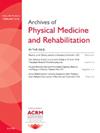Analysis of Conclusiveness over Time of Cochrane Systematic Reviews in Physiotherapy: A Methodological Study 0413
IF 3.6
2区 医学
Q1 REHABILITATION
Archives of physical medicine and rehabilitation
Pub Date : 2025-04-01
DOI:10.1016/j.apmr.2025.01.046
引用次数: 0
Abstract
Objectives
To determine the proportion of conclusive Cochrane reviews relevant to the field of physiotherapy and to investigate whether conclusiveness has been increasing over time.
Design
Methodological study.
Setting
PEDro database.
Participants
Two hundred Cochrane systematic reviews were randomly selected, with 50 from each of the 4 publication periods: 2000-2005, 2006-2010, 2011-2015, and 2016-2020.
Interventions
Not applicable.
Main Outcome Measures
Two independent reviewers extracted: year of publication, country, Cochrane Review Group, participants, intervention, comparators, primary outcomes, number of randomized controlled trials, total cumulative number of patients enrolled, and the need for further studies. Certainty of evidence was assessed using the Grading of Recommendations, Assessment, Development and Evaluation (GRADE), ranging from very low to high. GRADE data from primary outcomes were used if available, otherwise reviewers applied the GRADE approach to remaining outcomes after a set of prespecified criteria. To analyze change over time, chi-square tests of independence were used for GRADE proportions, criteria for downgrades, study conclusiveness, and reported need for further studies.
Results
Outcomes rated very low significantly increased over the 23 period from 14% in 2000-2005 to 34% in 2016-2020 (P<.001). Low-rated outcomes trended downward over the same period and outcomes rated moderate or high remained consistent. Proportion of high-rated outcomes never exceeded 5% per time period and composed 3% of the entire sample. Risk of bias was the most prevalent reason for downgrade, composing 45% of all outcome downgrades. Inconsistency demonstrated a time-wise increase from <1% in 2000-2005 to 9% in 2016-2020 (P<.001). Study conclusiveness remained unchanged (P>.05) and consisted of 4% of all studies in the sample. Proportion of conclusive studies was highest in 2016-2020 with 4 out of 50 (8%). Studies reporting no further research needs were also unchanged (P>.05) and did not exceed 14% of studies per time period, or 9% overall.
Conclusions
The proportion of Cochrane reviews deemed conclusive has not changed over time and remains a very small proportion of those published. Outcomes with high certainty of evidence are also few and remain unchanged. Further research is necessary in the physiotherapy field to provide higher quality evidence and improve conclusiveness in systematic reviews.
Disclosures
none.
求助全文
约1分钟内获得全文
求助全文
来源期刊
CiteScore
6.20
自引率
4.70%
发文量
495
审稿时长
38 days
期刊介绍:
The Archives of Physical Medicine and Rehabilitation publishes original, peer-reviewed research and clinical reports on important trends and developments in physical medicine and rehabilitation and related fields. This international journal brings researchers and clinicians authoritative information on the therapeutic utilization of physical, behavioral and pharmaceutical agents in providing comprehensive care for individuals with chronic illness and disabilities.
Archives began publication in 1920, publishes monthly, and is the official journal of the American Congress of Rehabilitation Medicine. Its papers are cited more often than any other rehabilitation journal.

 求助内容:
求助内容: 应助结果提醒方式:
应助结果提醒方式:


